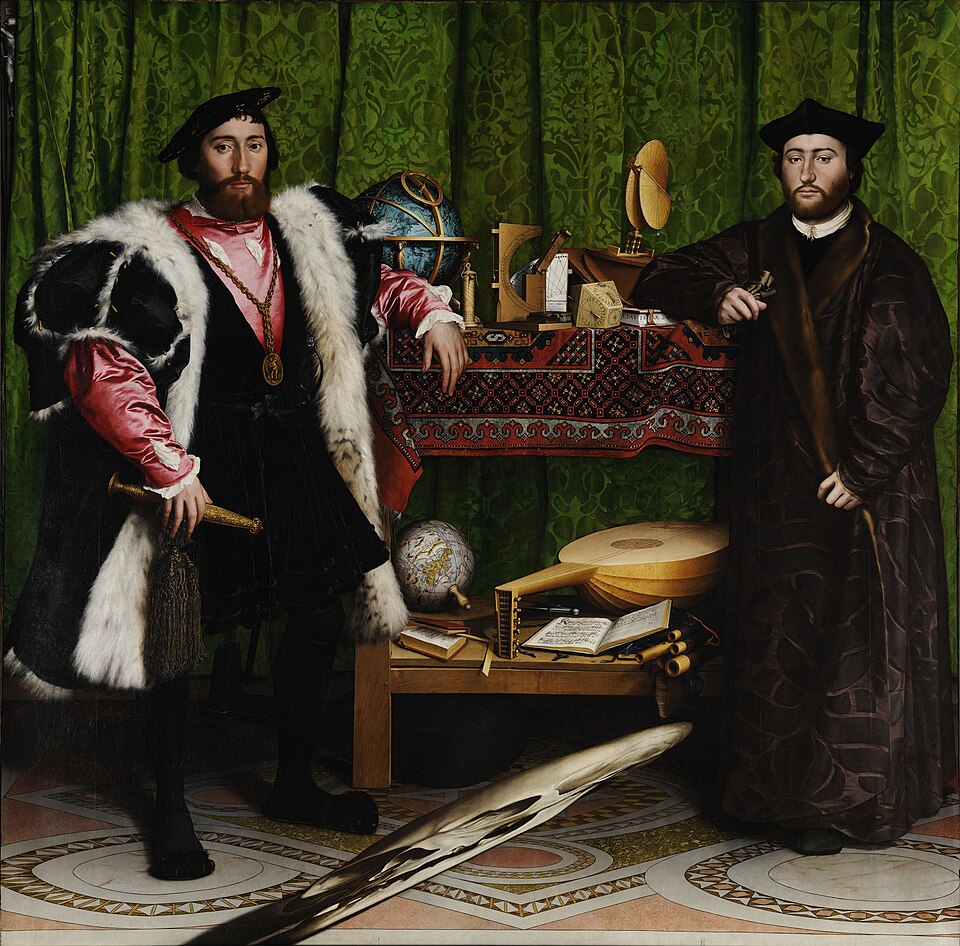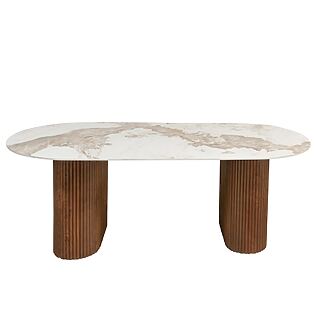we encounter "Memento Mori" in many forms, from classical art to modern musical albums from Depeche fashion and fire tail . This Latin expression has been warning to us humans since hundreds of years that we should not forget our mortality.
Toten heads, sand watches , expired candles and withered flowers-we find all of these motifs in Memento-Mori art that stimulates us to think about the transience of life. The word "Vanitas", which always falls in this context, comes from the Christian-Jewish idea that everything on Earth is transient. The term “memento mori” can be understood as an invitation to live life more intensely because it is so fleeting and fragile.
But Memento Mori is not just a historical phenomenon. In contemporary pop theory, the paradigms of recycling and synthetic retro trends a current topic-a culture that cannot let their own waste. In addition, museums are often referred to as the "cruise ships of culture" when it comes to their ecological effects. This modern interpretation shows how the old concept gains new meanings in our time.
What does "Memento Mori" mean?

illustration serves illustration purposes and was created with the help of an image AI
The Latin expression runs through art history like a thread, and its meaning goes far beyond a mere memory of death.
Origins and levels of meaning
The expression comes from the ancient Rome, where it was part of a strange ritual. During the victory parades there was a slave behind the general and held a gold or laurel wreath over his head, while he was constantly whispering with warning words:
- "Memento Mori." (Remember that you will die.)
- "Memento te hominem eat." (Remember that you are a person.)
- "Respice post te, hominem te memento." (Look around and keep in mind that you too are only a person.)
This practice served as a gesture of humans so that the general did not get his triumph to head. The proverb was forgotten for a while after the case of Rome, but in the 10th century it woke up again in the Christian world. There he developed into a symbol of vanitas - the transience everything earthly.
What is the difference between Memento Mori and Vanitas?
There are still small but important differences between the two ideas, although they are very similar. Vanitas, which "vanity" or "empty appearance" , is a Christian idea that emphasizes how meaningless it is to strive for earthly goods and beauty. The word comes from the book Kohelet and asks people to keep themselves away from certain sins and vanities.
On the other hand, Memento Mori is universal. It is less a warning than a memory - not in specific sins, but to the fundamental fact that everything is transient and death is safe. Memento Mori is across culture because it comes from the ancient Greek-Roman world and is not bound to a certain religion.
But these fine lines are often difficult to recognize in art. Hidden Memento Mori messages are common in still life from the 17th and 18th centuries. The baroque period is exemplary for the Vanitas motif, which shows life and death side by side.
Why death in art is so present
It is no coincidence that death is always addressed and illustrated in art. Knowing that you will die are a large part of what makes us human. This urge became particularly stronger in times of collective trauma. For example, the terrible plague , which swept through Europe in the 14th century and killed about a third of the population, intensified the idea of Memento Mori.
If we deal with death in art, we can understand that incomprehensible. Art is like a dance for life and it helps us to change our view of death and even feel it as a "delightful elixir of rejuvenation". "
very popular in medieval art The dead dance paintings, which showed skulls, sand watches and decaying bodies, should remind people that life is short and that they should prepare for the afterlife. symbolism of death reminds us of our own death, but in a strange way it also reminds us of how precious life is.
Memento Mori in art history
The artistic journey of Memento Mori has gone through thousands of years and impressively shows how different times have thought about the idea of transience. The history of death symbolism is profound and diverse, from old ceremonies to complex paintings.
Roman tradition and old roots
Memento Mori's roots go back to ancient Rome. There, said slave went with the victorious commander during his victory parade and whispered to him (see above). This was a symbolic act that showed how fleeting the most significant honors are.
Rediscovery in monasteries in the Middle Ages
The Memento-Mori motif was forgotten when the Roman Empire disassembled. It only reappeared in a manuscript by Noker from Zwiefalten from the Hirsau monastery in 1070, during the Cluniazensian reform . This movement was created because the church was in a miserable situation in the 10th century. Many popes had done terrible things, which made people lose their belief in the church. The reform called for more piety, stricter regulations for the clergy and a return to the idea that life is short.
In the late Middle Ages, many works of art appeared that typically represented death and decay in a dramatic way. But the warning of his own death also included the call to live a good life and earn "treasures of the Heavenly Empire" The concept of Memento Mori was particularly solidified in the everyday life of people in the wake of the Black Plague, which swept across Europe in the mid -14th century.
Baroque Vanitas-Stillleben as the highlight
The Memento Mori art culminated during the baroque period. Vanitas -Stillleben became the most typical type of baroque life. This painting style reached its peak in the 1620s, which were also the time of the terrible Thirty Years' War (1618–1648).
Ingvar Bergström divided the still lifes into three groups: symbols of earthly existence (books, musical instruments, money), symbols of transience (skull, sand watches , exposed candles) and symbols of rebirth (ears, laurel, Efeu). The paintings were "private devotional pictures" who helped people think about death and eternal life.
The example of Holbein's "The Messenger"
Hans Holbein's painting "The Messenger" from 1533 is a great example of Memento-Mori art. It shows Jean de Dinteville, the French diplomat at the courtyard of Heinrich VIII., And Georges de Selve, the Bishop of Lavaur. We see a deformed skull in the foreground of the image, which can only be seen correctly from a certain angle. This anamorphic skull is a great memory of how transient and wealth can be.

Furthermore, the painting contains another, easy to overlook Memento-Mori symbol: in the upper left corner, almost completely hidden behind a green curtain, there is a silver crucifix. These details make “the Messenger” into a prime example of how artists in their works in their works-as subtle, nevertheless urgent reminders to mortality themselves even the most powerful person.
Memento Mori today: between pop culture and protest
In our present, the Memento-Mori motif has undergone a transformation. The concept can be found in popular art forms as well as in political protest movements.
Depeche fashion and fire tail: music as modern vanitas
The discussion of the transience also shapes the modern music landscape. This is particularly striking for Depeche Mode , whose album was published in 2023 was entitled “Memento Mori” (the world reported).
Curious: A lot of the material was created before the death of her band member Andrew Fletcher, which gave the album an additional emotional depth. Martin Gore explained the title as a memory "that we are all mortal", while Dave Gahan specified: "That we have to die! Each of our songs is a memento mori, including the old ones".
In fact, Depeche Modes Music was always vanitas music, comparable to Dark Wave or Heavy Metal . The German band fire tail took up the concept. Her album "Memento Mori" combines medieval folk rock elements and a confrontation with human transience. The album sings "Great adventure, past battles and glorious heroicism" in typical fire-tailed manner " (source: fire tail band camp ) , while at the same time stimulating thinking about your own existence.
Art campaigns against climate change
protest against climate change has also achieved art. "Just Stop Oil" movement began to stick to famous paintings in 2022 to protest against the lack of radical climate policy. These actions began in Glasgow, where activists sprayed the lettering "Just Stop Oil" on museum walls and stuck their hands on the framework of a landscape painting ( Republic: The landscape painting as Memento Mori ).
One of the artists involved said: "No painting is worth more than the life of my six -month -old nephew. No sculpture can feed a baby" . These forms of protest specifically use the shock effect by showing how quickly known works could be destroyed. Ironically, many of these landscape paintings represent scenes "that no longer exists or will soon no longer exist" - a modern memento Mori for disappearing ecosystems.
Museums as political actors in anthropocene
At the same time, museums become more political. For example, the Royal Ontario Museum in Toronto hired the first "curator for climate change" . This change shows that more and more people are becoming aware of the climate crisis. Nevertheless, museums are in a difficult location: Julie's Bicycle , a non-governmental organization, carried out a study and found that museums have a disturbingly large ecological footprint that constitutes 41% of CO2 emissions of all cultural activities.
In response to this, the London Tate Modern in 2019 to play a unique role in making significant social changes. It promised to reduce its CO2 emissions by 50 % by 2023 and to be climate-neutral by 2030. Artists like Lisa Jackson use new technologies such as virtual reality to create idealized visions of the future, such as "nature conquers the city of Toronto" .
In this conflict between art and politics, the Memento-Mori motif, which has existed for hundreds of years, has been given a new, urgent meaning. It not only reminds us of our own mortality, but also how fragile the world is in which we live.
What memento Mori teaches us about life
The Memento Mori principle offers deep wisdom that has inspired people for thousands of years and stimulates to live more carefully.
Knowing that you will die
According to the stoic philosophy, death is nothing that should be afraid of; He is only the end of life. In a strange way, this view can make us live more fulfilling and true. Mark Aurel said this very clearly:
"If a God would tell you that you would die tomorrow or the day after tomorrow, you could only look forward to this 'the day after' if there is nothing noble in you".
Memento Mori is actually a great tool for self -reflection and targeted action. We often forget death in our daily life, even though it is guaranteed. Nevertheless, thinking About us eren death makes us aware that we don't have all the time in the world and urges us to live more intensely.
Appreciation of the moment
However, life is good "
wrote Goethe opposed the Christian Memento Mori his decisive "Memento Vivere" ("Gemenke") The appreciation of the beautiful moment was a main requirement for him:
Man is actually only called to work in the present ”.
Already in the European Middle Ages and to this day in most East Asian spiritual traditions there is a close link between the art of life and the topics of transience. Seneca emphasized that life only gains value through the awareness of one's own mortality, as it stimulates us to consider the current moment as a gift.
An ethical compass in everyday life
In practical life, the concept can serve as an ethical guide. By regularly remembering our finiteness, we are encouraged to rethink our priorities and concentrate on the essentials. Marcus Aurelius rieted:
Do not do as if you had thousands of years to live. Death hovers over your head. As long as you still live as long as you can still be a righteous person "
The value of this lifestyle is particularly evident in interpersonal relationships. We perceive smaller quarrels or disagreements with family members or friends differently and are ready to reconciliation faster. Anyone who thinks about death inevitably encounters profound questions: What is "death? Is "Death" a good or an evil? How should I reasonably behave on my own upcoming death?
In the end, this perspective can help us live a life that is important for ourselves not only for ourselves, but also for others.
How artists work with the motif today
The contemporary art world reinterprets the motif in a fascinating way, with modern media and current social challenges focus.
Contemporary Vanitas interpretations
Contemporary artists have taken up and redefined the traditional Vanitas motif. Exhibitions such as “ Vanitas Contemporary ” present outstanding examples of international art and photography, which range from social decadence to advertising aesthetic representations to abstract image metamorphoses.
In addition to classic symbols such as skulls, modern vanitas paintings also use new forms of expression, with artists such as Tarek , Ska and Ykstreetart simplify the motif, while other more detailed representations create.
Digital art and virtual reality
In the digital age, allegories of death also find new forms of expression. Projects such as "Digital Memento Mori" by Forevermidi serve as a significant memory in virtual environments that are often devoted to idealization and unrealistic self -image.
Artists such as Lisa Jackson Virtual Reality also use to create utopian visions of the future. In her film "Biidaaban: First Light" nature conquered the city of Toronto, which also heals wounds from the colonial past.
Eco art and sustainable exhibitions
Environmental issues have also enriched the motif. Ursulinenkirche in Linz have been exhibited under the guiding theme "Memento Mori" for about three decades that deal with current topics such as the fragility of creation and ecological changes. After the years of pandemic, these exhibitions represent "a strong sign of life outstanding young artists" .
Example: Liz Larner and recycled sculptures
The California artist Liz Larner has created an impressive example of modern memento-morin art with her recycled sculptures. In the Kunsthalle Zurich, she presented an installation of plastic waste that she had fished out of the sea. Their work "Meerfum Drift" consists of children's toys, bags and packaging that are merged into one another.
Larner examines why some parts sink in the water and swim others. Their art combines established and unorthodox perspectives with a detailed knowledge of history, form and material, while at the same time drawing attention "a disaster that we do not have under control"
Why Memento Mori is more current than ever
If we look at the path of Memento Mori through the centuries, there is a remarkable continuity: the apparently dark motif ultimately turns out to be a life affirmation. While the forms of representation have changed - from whispering slaves in triumphal roma to baroque still lifes to digital art and environmental activism - the core message remains unchanged. In fact, in view of the climate crisis, this ancient wisdom even gains new urgency.
Recognizing the transience does not mean renouncing life. On the contrary: only the awareness of our finiteness gives its true value at the moment. “Memento Vivere” - Gemenke - thus becomes the logical consequence of the Memento Mori. The stoic philosophy teaches us that this knowledge can be liberating. Those who accept their own mortality live more consciously, more authentic and often more generously.
What is particularly fascinating is how contemporary artists take up and reinterpret this motif. Whether through recycled plastic waste in Liz Larner's work or digital vanitas depictions, they hold a mirror up to us while simultaneously pointing out new paths forward. In doing so, they extend the memento mori concept to our entire environment: what is threatened today could be irretrievably lost tomorrow.
Ironically, the occupation with transience leads us to more liveliness. Those who do not displace death live more intensely. Those who recognize the fragility of our existence often find a deeper connection to others. Regardless of whether we follow a religious worldview or not-the Memento-Mori idea reminds us that our time is limited. This knowledge makes every encounter, every sunset, every work of art more precious.

Owner and Managing Director of Kunstplaza. Publicist, editor, and passionate blogger in the field of art, design, and creativity since 2011. Successful completion of a degree in web design as part of a university program (2008). Further development of creativity techniques through courses in free drawing, expressive painting, and theater/acting. Profound knowledge of the art market through many years of journalistic research and numerous collaborations with actors/institutions from art and culture.

















